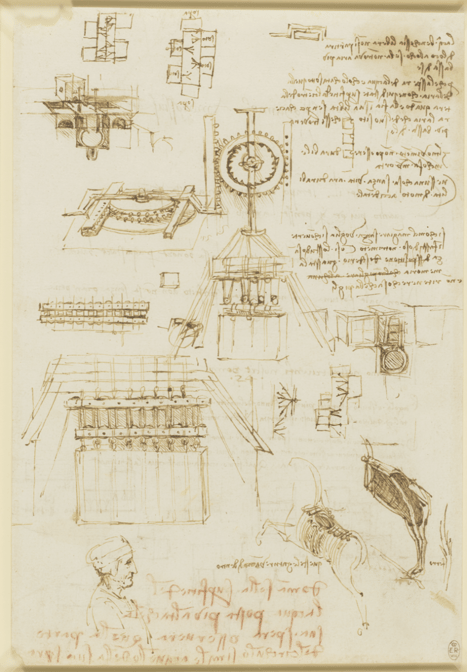
Innovative Inventions: The Royal Collection's Da Vinci Sketches
Bridgeman Images are proud to represent The Royal Collection, one of the largest and most important art collections in the world, and one of the last great European royal collections to remain intact. Comprising almost all aspects of the fine and decorative arts and running to more than a million objects, the Collection is a unique and valuable record of the personal tastes of kings and queens over the past 500 years.
This month, Bridgeman Images takes a close look at the Royal Collection's range of sketches and diagrams created by Leonardo da Vinci. While Leonardo is one of history's most recognised artists, as a true Renaissance man the artist, scientist, architect and engineer also spent a large portion of his time envisioning scientific and exploratory tools, war machines and various other mechanical objects.

This piece, labelled as studies of gun-barrels and mortars involves a cradle at the centre of a construction intended for mounting the gun above, with two opposed barrels so that one could be loaded while the other was fired.
The selection of inventions thought up by the artist covered a wide range of disciplines, and are famous not just because of the visual artistry and intricacy of the designs but because of the fact that many of these structures, weapons and machines were designed long before the appropriate technologies and systems needed to build them had even been conceptualised.
These are some of Leonardo's designs for the casting of a bronze equestrian monument to Francesco Sforza, Duke of Milan (1401-66). Such a monument is first mentioned in a letter of November 1473 from his son Galeazzo Maria to the commissar of the ducal works, instructing him to find an artist capable of carrying out the work. In 1480, Leonardo wrote to Sforza's son: 'I can carry out sculpture in marble, bronze or clay, and also I can do in painting whatever may be done, as well as any other, be he who he may. Again, the bronze horse may be taken in hand, which is to be to the immortal glory and eternal honour of the prince your father of happy memory, and of the illustrious house of Sforza.'
While many of Leonardo's inventions and designs were decorative or symbolic, some had destructive capabilities. This image depicts the usage of mortar bombs to destroy a fortress and was probably acquired for the collection of Charles II. Leonardo was also fascinated with the world around him and also spent time designing flying machines, parachutes and ground vehicles to navigate the globe.
This example details several designs for chariots and weaponry: a design for a war-machine which, when pulled by two horses, will cause canon-balls to fly out horizontally; below the same war-machine as above, with the canon-balls replaced by spiked clubs.
These sketches and designs include concepts for a water-powered clock and a decorative costume. While staying in Venice in 1500, Leonardo designed a kind of scuba diving gear, which was essentially a leather diving suit designed principally for sneak attacks on enemy vessels from underwater.
The principal study on this sheet depicts, in cutaway, a mechanical boat operated by two men (one obscured by ink dribbled across the sheet). The men seem to be turning a large horizontal wheel, geared to a smaller vertical wheel on a transverse axle, while the man in the stern is leaning against another transverse axle bearing a toothed wheel. A chain running from the middle of the boat to the bow may be some folding mechanism, which would explain the sketch to the right, of a man carrying on his back what seems to be a folded boat. At centre is a figure with a tight-fitting seal around his waist; long faint lines to either side suggest this might be some sort of canoe.
The selections on this page from The Royal Collection are complemented in the Bridgeman Archive by a range of other designs and machines from other collections, famously Leonardo's mobile war machine and flying machine concepts.
Leonardo proved in these fascinating sketches and journal extracts that he was a forward thinking man well ahead of his time in addition to his known reputation as a skilled artist and painter.
Discover additional Leonardo content from this collection
Leonardo da Vinci - further images of inventions and sketches
Browse the whole of The Royal Collection on Bridgeman Images






